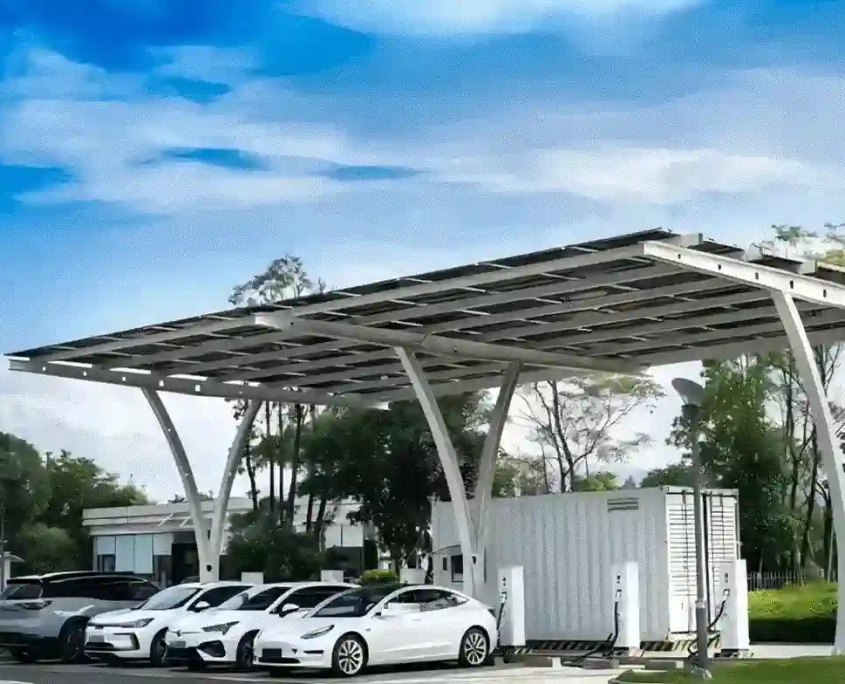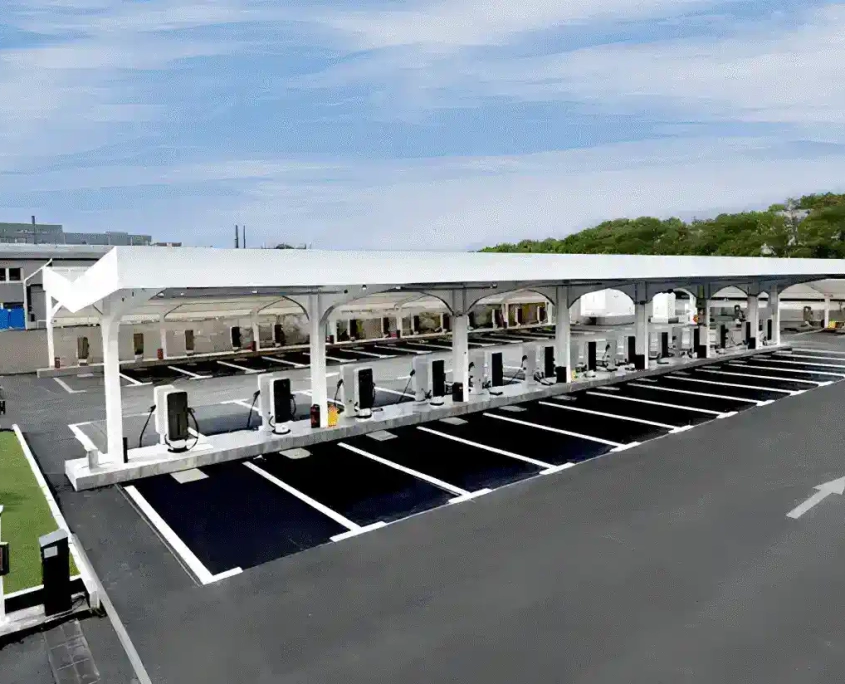Table of Contents
Mastering Efficiency with PVSCD Stations for EVs
As more electric cars hit the roads, there are problems with the charging stations. Some issues include bad layout and too much power load. However, the combined solar storage and charging stations can help. They can reduce the stress on the power grid from all the electric cars charging. Plus, they use clean energy to cut down on carbon dioxide, which matches the “dual carbon” goal. This means they’re good for our planet. These systems also solve the problem of not having enough land. They allow solar energy to be used right away, increase the use of clean energy, and cut down on carbon. This way, they balance the power load and save money.
Delving into the Mechanism of Photovoltaic Storage and Charge-Discharge Stations
“Photovoltaic Storage and Charge-Discharge (PVSCD) Stations and Their Working Principles” The term “Photovoltaic Storage and Charge-Discharge” or PVSCD for short, as the name suggests, encompasses an integrated charging station principally made up of four components – solar photovoltaic generation, energy storage batteries, charging stations, and bidirectional charging. Digging deeper, the PVSCD station comprises subsystems such as the power supply and distribution system, energy storage system, solar photovoltaic generation system, and charging system. Within this framework, the system integrates solar cell arrays, photovoltaic inverters, batteries, bidirectional AC converters, charging stations, and DC-DC converters, among other equipment.
So, how exactly does the Photovoltaic Storage and Charge-Discharge (PVSCD) station operate? At its core, the primary mechanism revolves around formulating day-ahead operational strategies based on vehicle charging behaviors and solar photovoltaic output. Within the integrated station, the energy generated by the solar photovoltaic system first meets the charging station’s demands. In situations where this energy isn’t sufficient to meet load requirements, the energy storage system discharges. If that’s still insufficient, electricity is purchased from the grid. Conversely, when solar output exceeds demand, the excess energy can either charge the storage system or be sold to the national grid, thus generating revenue. The energy storage system flexibly adjusts its charge-discharge patterns based on solar generation and electricity pricing. This reduces peak-load discrepancies at charging stations, optimizes coupled efficiency, and enhances the overall economic and environmental performance of the system.
Efficiency Mastery: The Operational Secrets of PVSCD Stations
Complementary Multi-energy, Peak Shaving, and Valley Filling
First and foremost, a PVSCD station, with its integrated energy management, optimally utilizes clean energy for power. Solar photovoltaic units, energy storage, and charging (or discharging) facilities electrically interconnect, creating a microgrid. This grid leverages renewable energy sources (like solar and wind) for energy storage, or uses off-peak power during nighttime for battery charging. When electric vehicles need charging, it releases this green energy. By smartly interacting with the public grid based on charging needs, it can operate in both grid-connected and off-grid modes, enhancing the reliability of power supply to the charging service center. The application of solar + energy storage system alleviates the grid impact during high-current charging. Thus, this complementary multi-energy management approach not only supplies electric vehicles with clean energy but also offers grid services like peak shaving, effectively enhancing grid efficiency.

Efficient Maintenance and Enhanced User Experience
- Facilitating Maintenance: Charging stations, being electrical infrastructures, often require routine maintenance. The scattered nature of charging points, with small installed capacity and sometimes illogical layout, poses challenges for maintenance management. Online service orders for maintenance have stringent timelines, making it exhausting for personnel and sometimes resulting in delayed arrivals – hiking costs and road safety risks. Centralized PVSCD stations allow for manned maintenance shifts or the addition of remote monitoring equipment, significantly easing the workload and improving maintenance efficiency.
- Elevated Customer Charging Experience: Firstly, PVSCD stations adhere to uniform construction standards, housing self-service snack shopping areas, rest and movie zones, hot water facilities, restrooms, and other amenities. Secondly, their capacity to accommodate more charging requests means no long queues, thereby heightening customer satisfaction.
Unified Construction and Diverse Services
- Resource Consolidation and Cost Savings: PVSCD stations aim to maximize economic benefits by leveraging the advantages of centralized charging sites like larger areas, higher acceptance capacity, and efficient power usage. Installing solar systems on existing carport roofs not only serves as conventional shelters but also offers economic value through energy generation. This reduces land use, saves on land resources, and prolongs the life of the shelter. The station also facilitates the recycling of used EV batteries, curbing potential pollution and wastage of resources.
- Diverse Services and Enhanced Operational Profits: By increasing the self-consumption rate of solar generation and setting scientifically-driven energy storage charge/discharge strategies, the full economic value of solar storage is realized. Developers liaise with governmental bodies to secure subsidies, reducing investment costs. Furthermore, tapping into the potential of the charging market by employing online tactics (like charging apps and social media promotions) and offline strategies (collaborating with EV dealers, ride-hailing companies, etc.) helps secure a broader customer base. Additional services like car washing can shorten the return on investment period, setting a positive trend for future developments.
As we can see, advancing the construction of Photovoltaic Storage and Charging (PVSC) stations is a pivotal initiative in propelling electric vehicles from a “low-carbon” trajectory to a “zero-carbon” future. Not only does it save on distribution capacity expansion costs and participate in peak shaving and valley filling, but it also effectively mitigates the intermittent and unstable nature inherent to renewable energy generation. Furthermore, by fully harnessing clean energy, it accelerates the transformation of our energy structure, ultimately bolstering our dual-carbon goals.


